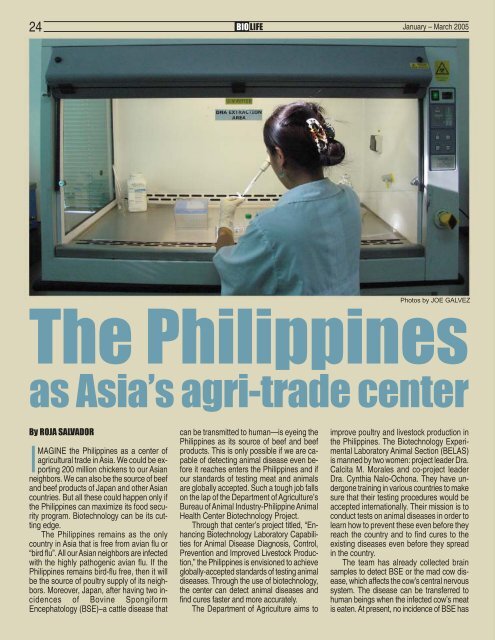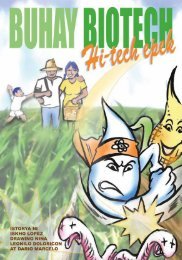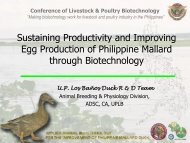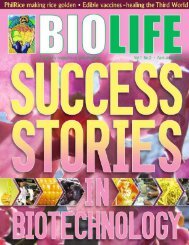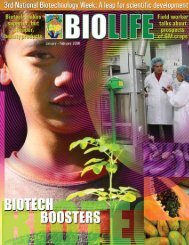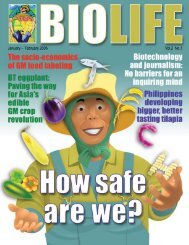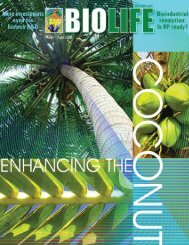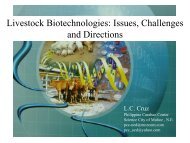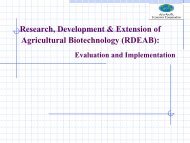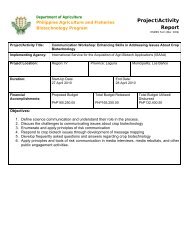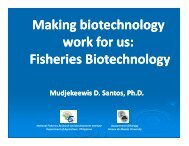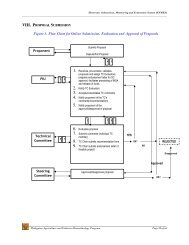Download PDF - SEARCA Biotechnology Information Center
Download PDF - SEARCA Biotechnology Information Center
Download PDF - SEARCA Biotechnology Information Center
Create successful ePaper yourself
Turn your PDF publications into a flip-book with our unique Google optimized e-Paper software.
24 BIO LIFE January – March 2005<br />
Photos by JOE GALVEZ<br />
The Philippines<br />
as Asia’s agri-trade center<br />
By ROJA SALVADOR<br />
IMAGINE the Philippines as a center of<br />
agricultural trade in Asia. We could be exporting<br />
200 million chickens to our Asian<br />
neighbors. We can also be the source of beef<br />
and beef products of Japan and other Asian<br />
countries. But all these could happen only if<br />
the Philippines can maximize its food security<br />
program. <strong>Biotechnology</strong> can be its cutting<br />
edge.<br />
The Philippines remains as the only<br />
country in Asia that is free from avian flu or<br />
“bird flu”. All our Asian neighbors are infected<br />
with the highly pathogenic avian flu. If the<br />
Philippines remains bird-flu free, then it will<br />
be the source of poultry supply of its neighbors.<br />
Moreover, Japan, after having two incidences<br />
of Bovine Spongiform<br />
Encephatology (BSE)–a cattle disease that<br />
can be transmitted to human—is eyeing the<br />
Philippines as its source of beef and beef<br />
products. This is only possible if we are capable<br />
of detecting animal disease even before<br />
it reaches enters the Philippines and if<br />
our standards of testing meat and animals<br />
are globally accepted. Such a tough job falls<br />
on the lap of the Department of Agriculture’s<br />
Bureau of Animal Industry-Philippine Animal<br />
Health <strong>Center</strong> <strong>Biotechnology</strong> Project.<br />
Through that center’s project titled, “Enhancing<br />
<strong>Biotechnology</strong> Laboratory Capabilities<br />
for Animal Disease Diagnosis, Control,<br />
Prevention and Improved Livestock Production,”<br />
the Philippines is envisioned to achieve<br />
globally-accepted standards of testing animal<br />
diseases. Through the use of biotechnology,<br />
the center can detect animal diseases and<br />
find cures faster and more accurately.<br />
The Department of Agriculture aims to<br />
improve poultry and livestock production in<br />
the Philippines. The <strong>Biotechnology</strong> Experimental<br />
Laboratory Animal Section (BELAS)<br />
is manned by two women: project leader Dra.<br />
Calcita M. Morales and co-project leader<br />
Dra. Cynthia Nalo-Ochona. They have undergone<br />
training in various countries to make<br />
sure that their testing procedures would be<br />
accepted internationally. Their mission is to<br />
conduct tests on animal diseases in order to<br />
learn how to prevent these even before they<br />
reach the country and to find cures to the<br />
existing diseases even before they spread<br />
in the country.<br />
The team has already collected brain<br />
samples to detect BSE or the mad cow disease,<br />
which affects the cow’s central nervous<br />
system. The disease can be transferred to<br />
human beings when the infected cow’s meat<br />
is eaten. At present, no incidence of BSE has


